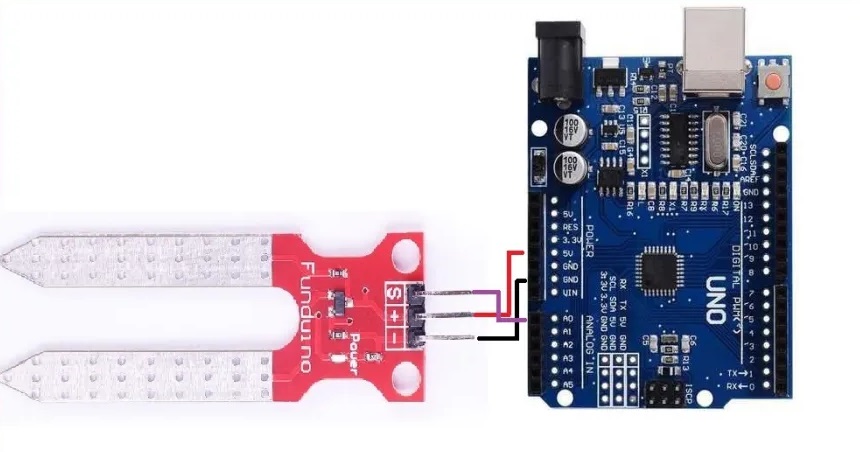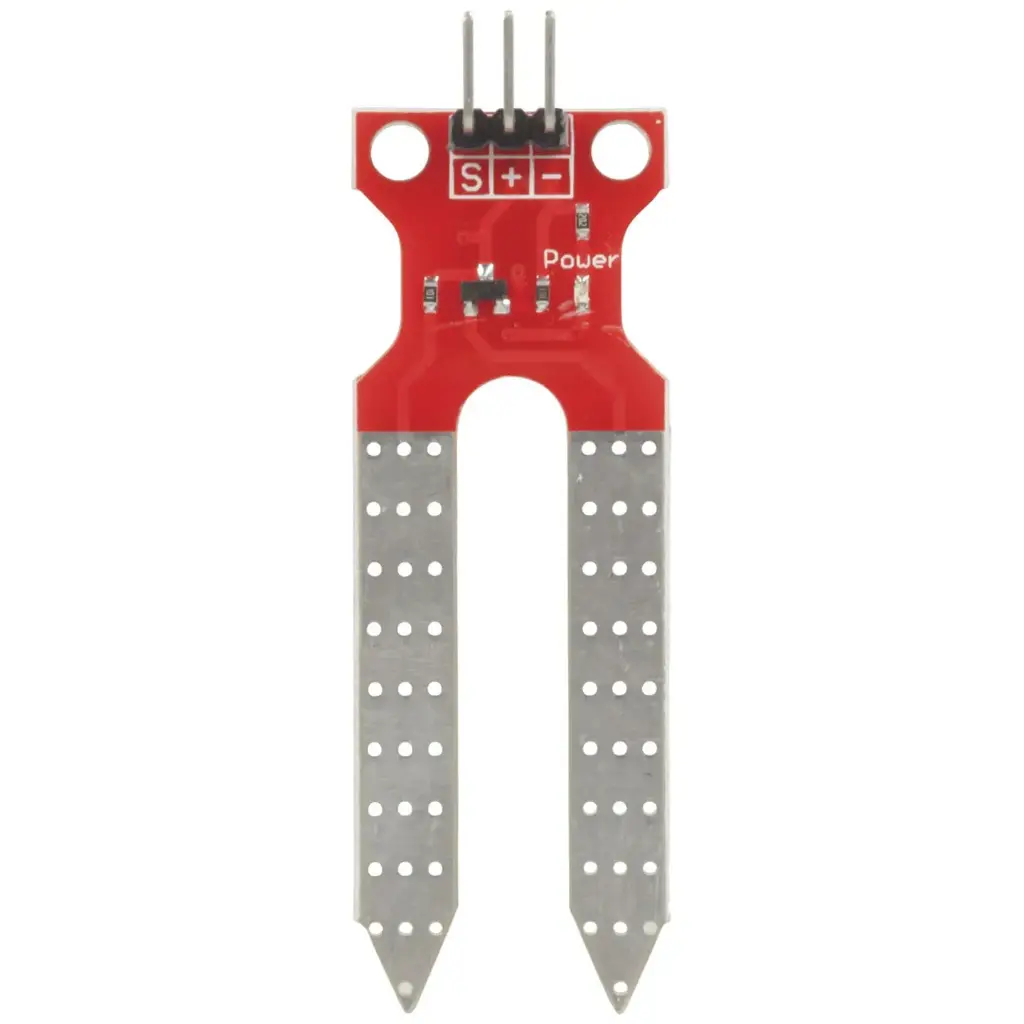Features:
- This moisture sensor is extremely sensitive and can detect soil humidity.
- When the soil is deficient in water, the module will provide low simulation values; otherwise, it will produce high simulation values.
- With this sensor, you may create an automated watering mechanism to save your plants from withering due to a lack of water while you are gone for an extended period of time or have missed watering time.
- These sensors can help your plants grow more comfortably and make your garden smarter.
- The surface has undergone plating treatment to improve electrical conductivity and corrosion resistance.
- Simple to set up
Principle of Work:
We simply need to attach the fork-shaped conductive probe to the soil since it has two exposed conductive plates that act as a variable resistor, increasing in resistance depending on the moisture content of the soil. The resistance of the probe is inversely proportional to the instrument's soil moisture. Soil conductivity increases with soil wetness, decreasing resistance. Soil conductivity diminishes when soil moisture content increases, resulting in higher resistance. This sensor provides an output voltage by measuring resistance, allowing us to compute the moisture content.
Pinout of the Module:

The S (Analog Output) pin outputs an analog signal ranging from 5V to 0V.
GND stands for ground.
The sensor is powered by the VCC pin. It is recommended that the sensor be powered from 3.3V to 5V. Please keep in mind that the analog output will vary depending on the voltage supplied to the sensor.
Applications:
- Gardening monitoring system
- Watering system
Circuit:
The module's Ground and VCC pins must be connected to the Arduino Board's Ground, and the S pins to pin A0 on the Arduino Board.

Library:
no library is needed.
Code:
int moisture = 0;
int percentage = 0;
void setup()
{ Serial.begin(9600); // serial monitor baud rate
pinMode(A0, INPUT); // PinMode set, pin for moisture sensor
}
void loop()
{
moisture = analogRead(A0); // reading value
percentage = map(moisture, 0, 1023, 0, 100); // changing to percent
Serial.print("Moisture= ");
Serial.print(percentage); // Print percentage
Serial.println("%");
delay(1000);
}
Once the sketch has been uploaded, open a Serial Monitor window to view the Arduino's output. you can see the soil moisture percentage on SerialMonitor with intervals of 1 second.
Technical Details:
- Color: Red + Silver
- Material: RF4
- Power Supply: 33V or 5V
- Working Current: Less than 20mA
- Output Voltage: 0~5 (5V when the sensor is completely soaked in the water)
- Supply Voltage: 5V
- Sensor Type: Analog output
- Service Life: 1 year approximately
- Weight: 70g
- Packaging Dimensions: 1200 x 780x 100mm
Resources:
Comparisons:
The primary problem with resistive soil moisture sensors like this one is corrosion of the sensor probes, which occurs not only because the sensor is in touch with the soil, but also because a DC current is flowing, causing electrolysis of the sensors. To address the issue, individuals have resorted to capacitive probes. Capacitive measurement has certain advantages over resistance measuring in that it not only prevents probe corrosion but also provides a more accurate readout of soil moisture content. It does not, in fact, measure moisture (as water is a bad conductor of current), Instead, it measures the ions that are dissolved in the fluid, thus adding fertilizer, for example, will reduce soil resistance even if no water is provided. Capacitive measurement essentially measures the dielectric generated by the soil, with water being the most critical ingredient in forming that dielectric.
Features:
- This moisture sensor is extremely sensitive and can detect soil humidity.
- When the soil is deficient in water, the module will provide low simulation values; otherwise, it will produce high simulation values.
- With this sensor, you may create an automated watering mechanism to save your plants from withering due to a lack of water while you are gone for an extended period of time or have missed watering time.
- These sensors can help your plants grow more comfortably and make your garden smarter.
- The surface has undergone plating treatment to improve electrical conductivity and corrosion resistance.
- Simple to set up
Principle of Work:
We simply need to attach the fork-shaped conductive probe to the soil since it has two exposed conductive plates that act as a variable resistor, increasing in resistance depending on the moisture content of the soil. The resistance of the probe is inversely proportional to the instrument's soil moisture. Soil conductivity increases with soil wetness, decreasing resistance. Soil conductivity diminishes when soil moisture content increases, resulting in higher resistance. This sensor provides an output voltage by measuring resistance, allowing us to compute the moisture content.
Pinout of the Module:

The S (Analog Output) pin outputs an analog signal ranging from 5V to 0V.
GND stands for ground.
The sensor is powered by the VCC pin. It is recommended that the sensor be powered from 3.3V to 5V. Please keep in mind that the analog output will vary depending on the voltage supplied to the sensor.
Applications:
- Gardening monitoring system
- Watering system
Circuit:
The module's Ground and VCC pins must be connected to the Arduino Board's Ground, and the S pins to pin A0 on the Arduino Board.

Library:
no library is needed.
Code:
int moisture = 0;
int percentage = 0;
void setup()
{ Serial.begin(9600); // serial monitor baud rate
pinMode(A0, INPUT); // PinMode set, pin for moisture sensor
}
void loop()
{
moisture = analogRead(A0); // reading value
percentage = map(moisture, 0, 1023, 0, 100); // changing to percent
Serial.print("Moisture= ");
Serial.print(percentage); // Print percentage
Serial.println("%");
delay(1000);
}
Once the sketch has been uploaded, open a Serial Monitor window to view the Arduino's output. you can see the soil moisture percentage on SerialMonitor with intervals of 1 second.
Technical Details:
- Color: Red + Silver
- Material: RF4
- Power Supply: 33V or 5V
- Working Current: Less than 20mA
- Output Voltage: 0~5 (5V when the sensor is completely soaked in the water)
- Supply Voltage: 5V
- Sensor Type: Analog output
- Service Life: 1 year approximately
- Weight: 70g
- Packaging Dimensions: 1200 x 780x 100mm
Resources:
Comparisons:
The primary problem with resistive soil moisture sensors like this one is corrosion of the sensor probes, which occurs not only because the sensor is in touch with the soil, but also because a DC current is flowing, causing electrolysis of the sensors. To address the issue, individuals have resorted to capacitive probes. Capacitive measurement has certain advantages over resistance measuring in that it not only prevents probe corrosion but also provides a more accurate readout of soil moisture content. It does not, in fact, measure moisture (as water is a bad conductor of current), Instead, it measures the ions that are dissolved in the fluid, thus adding fertilizer, for example, will reduce soil resistance even if no water is provided. Capacitive measurement essentially measures the dielectric generated by the soil, with water being the most critical ingredient in forming that dielectric.


